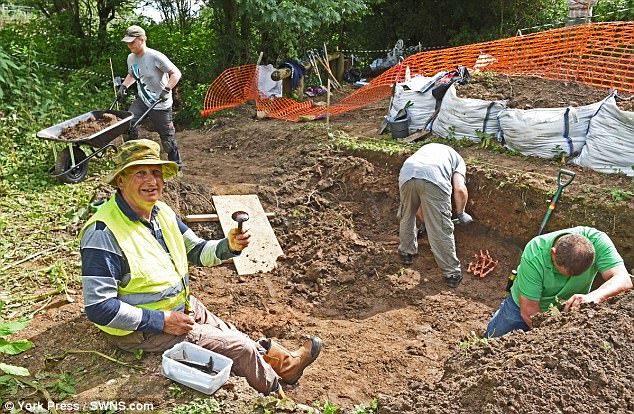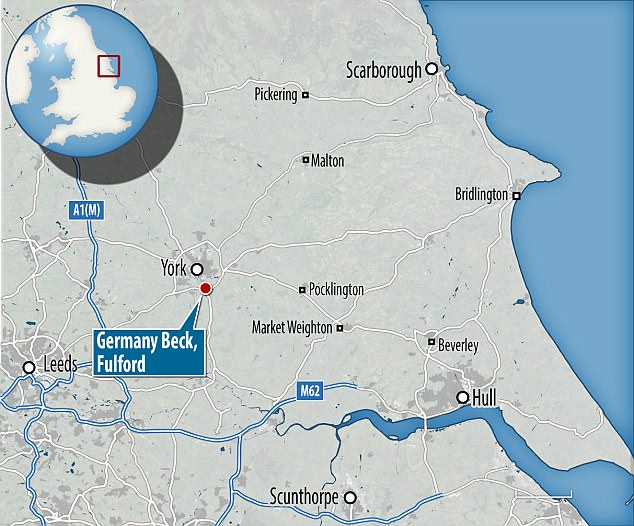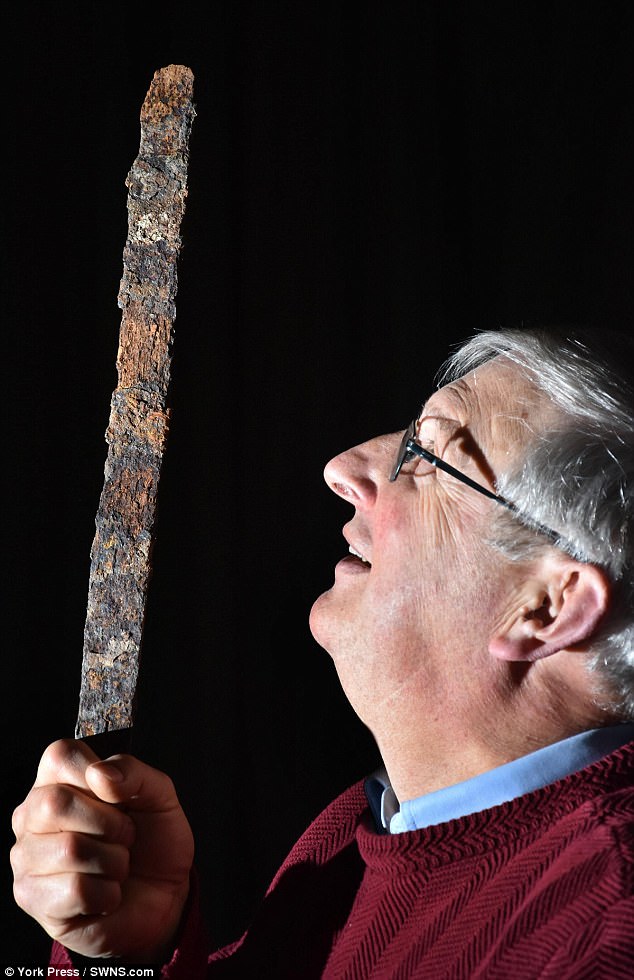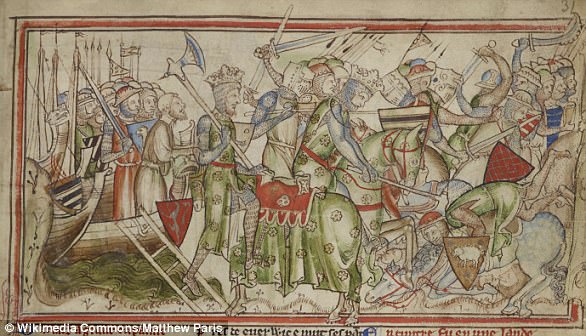It was a key battle that changed the course of British history.
Now, a lengthy investigation has revealed the site of the 1066 Battle of Fulford in York.
Archaeologist Charles Jones says the compelling evidence shows 'beyond any sensible doubt' that the historic battle in the city of York took place on land now being prepped for new housing.
Site of the 1066 Battle of Fulford that changed the course of British history is confirmed to be on a housing estate near York
An archaeologist claims the exact site of the Battle of Fulford has been revealed
He says axes, arrows, and swords prove the battle was fought at Germany Beck
He was at loggerheads with house developers planning 655 homes on the site
After a lengthy legal battle, the new housing estate is set to be built on the site
The Battle of Fulford was fought between the English King Harold Godwinson and Norse Kind Harold Hardrada after Hardrada tried to claim the English throne
By Cecile Borkhataria For Mailonline
14 February 2018
It was a key battle that changed the course of British history.
Now, a lengthy investigation has revealed the site of the 1066 Battle of Fulford in York.
Archaeologist Charles Jones says the compelling evidence shows 'beyond any sensible doubt' that the historic battle in the city of York took place on land now being prepped for new housing.
He says a cache of weapons including axes, arrows and swords found during a dig proves the conflict was fought at Germany Beck, York.
Mr Jones was at loggerheads with house builders Persimmon Homes over a long-running campaign to prevent plans for 655 homes being built on the site.
However, after a lengthy legal battle, the new homes on the 60-acre site were eventually approved and are set to be built soon.

Charles Jones, an archaeologist, at a dig at Fulford site. Jones claims an investigation revealed the site of the 1066 Battle of Fulford - which is set to become a new housing estate. He says the compelling evidence shows 'beyond any sensible doubt' that the battle site has been located
Mr Jones said: 'The narrative of any site will, of course, be endless - but we must be brave and state a clear conclusion when it's justified.
'Just accept that archaeologists are going to argue with you; but please remind them of the damage they do when they publicly nit-pick while avoiding the big picture.
'In this spirit, I am happy to state that we have, beyond any sensible doubt, located the 1066 battle site at Fulford.'
The Battle of Fulford preceded other well-known 1066 battles, including Stamford Bridge, which later set up the famous battle of Hastings.
Following the death King Edward the Confessor of England at the beginning of 1066, Viking invaders attempted to take the North of England, and then the throne, for their own.
England's new ruler, King Harold Godwinson, faced off against a Norse army in the 'Battle of Fulford', a bloody and gruesome battle that the Saxon side lost.
The invading forces' victory was short lived as King Harold slaughtered the Norse army in a surprise attack at Stamford Bridge in East Riding, Yorkshire, just five days later.

Archaeologist Charles Jones says a cache of weapons including axes, arrows, and swords found during a dig proves the 1066 Battle of Fulford was fought at Germany Beck near York (shown in this map). The Battle took place over marshland and water meadow terrain
Mr Jones has spent more than two decades researching the Battle of Fulford.
He argues the 80-acre Germany Beck site on the southern outskirts of York is the most probable location.
In November 2012, English Heritage, which protects and promotes historical sites around the country, took advice from a Battlefield Advisory Panel and refused to designate Mr Jones's Fulford site on an official Battlefield Register.
The decision was upheld on review in July 2013.
English Heritage experts concluded that even though it was 'probable' Germany Beck was the battlefield site the evidence was 'insufficiently conclusive' to 'securely identify' it for registration.

Archaeologist Charles Jones with the the remains of a sword uncovered at the site of the Battle of the 1066 Battle of Fulford - which is now a new housing estate. Caches of weapons including axes, arrows and swords have were found at the site in Germany Beck, Yorkshire
In May 2014, Jones challenged the refusal in a High Court fight to protect the site.
York firms Persimmon Homes and Hogg Builders want to build 655 homes on the site, but if it is recognised by English Heritage it will receive a degree of protection from developers.
Ian Dove QC, for Mr Jones, argued at London’s High Court that the 2012 decision not to recognise the site as a battlefield cannot stand.
He said as part of Mr Jones' 2014 High Court case that the 'decision makers' failed to apply the correct 'location' test.
That involved consideration of whether there was evidence that a battle had occurred in a particular location 'with a fair degree of probability'.
The QC told Mr Justice Lindblom the test was contained in the Battlefield Designation Selection Guide: The only up-to-date statement of English Heritage’s designation policy.
Mr Dove said it was uncontroversial that 'absolute proof for the boundaries of a battle' was rarely possible.
Referring to English Heritage, he said: 'If they did not apply the ‘fair degree of probability’ test to the question of location then unarguably they erred in law in the decision they reached.'
Now, Mr Jones claims to have found a cache of weapons including axes, arrows, and swords that he says proves the conflict was fought at Germany Beck.
WHY DID THE 1066 BATTLE OF FULFORD TAKE PLACE?
Historical context

A portrait of King Harold Godwinson of England, who ascended to the throne following the dearth of King Edward the Confessor
The Battle of Fulford took place at Germany Beck in Fulford, North Yorkshire, on September 20, 1066.
The battle took place following the death of Kind Edward the Confessor of England in early January, 1066, without clarifying his preference for succession.
In his place, Harold Godwinson (son of Godwin, Earl of Wessex), became King.
However, two other nobles claimed the throne as well: Harald Hardrada, King of Norway, and William, Duke of Normandy.
While William gathered a fleet and waited for favorable winds in order to cross the Channel to reach the South of England, King Harald gathered his Norse forces across the North Sea. King Harald also had the support of Earl Tostig, King Harold's exiled brother.
King Harald and his forces sailed across the North Sea to the mouth of the Tyne, where he joined Earl Tostig.
Tostig claimed the Earldom of Northumbria and was willing to support Harald's invasion in return for his help in gaining the Earldom.
Their joint forces likely numbered more than 10,000 armed men - by comparison, the Norman army that won at the Battle of Hastings soon after the Battle of Fulford numbered less than 7,000.

A stained glass window portrait of King Harald Hardrada of Norway, in Lerwick Town Hall, Shetland Islands
It's likely that Kind Harold, in the south, received news of the Norse forces, and began to march north.
King Harald marched to York and met the defending army made up of troops from Mercia and Northumbria, at Fulford, on the outskirts of York.
The Battle
The terrain around Fulford was flat but sodden - it consisted of areas of marshland.
The Norwegian army advanced along the banks of a ditch leading east from the River Ouse, but the English army attacked and pushed them back.

The arrival of King Harald of Norway and his defeat of the Northumbrians at Fulford, from The Life of King Edward the Confessor by Matthew Paris, 13th century
However, King Harald kept the bulk of his troop back against the river, so when English troops advanced, Harald's forces attacked from the left and swept around, trapping the English against the ditch.
The battle was fierce and, eventually, the English lost. Some were trapped against the ditch, others ran away and many were killed.
Some accounts claim that there were so many dead bodies, the Norse were able to moved across the area without getting their feet wet.

King Harold II and his forces were defeated by William of Normandy during the Battle of Hastings in October, 1066
York surrendered to the Norse invaders, and King Harald then travelled to Stamford Bridge to wait for the gathering of hostages in the region.
The victory, however, was short-lived.
Just five days later, King Harold's forces surprised Harald's at Stamford Bridge on September 25, 1066, and the Norse forces were defeated. King Harald was also killed, as well as Earl Tostig.
Soon after though, King Harold and his forces were defeated by William of Normandy during the Battle of Hastings on October 14, 1066.
Now, a lengthy investigation has revealed the site of the 1066 Battle of Fulford in York.
Archaeologist Charles Jones says the compelling evidence shows 'beyond any sensible doubt' that the historic battle in the city of York took place on land now being prepped for new housing.
Site of the 1066 Battle of Fulford that changed the course of British history is confirmed to be on a housing estate near York
An archaeologist claims the exact site of the Battle of Fulford has been revealed
He says axes, arrows, and swords prove the battle was fought at Germany Beck
He was at loggerheads with house developers planning 655 homes on the site
After a lengthy legal battle, the new housing estate is set to be built on the site
The Battle of Fulford was fought between the English King Harold Godwinson and Norse Kind Harold Hardrada after Hardrada tried to claim the English throne
By Cecile Borkhataria For Mailonline
14 February 2018
It was a key battle that changed the course of British history.
Now, a lengthy investigation has revealed the site of the 1066 Battle of Fulford in York.
Archaeologist Charles Jones says the compelling evidence shows 'beyond any sensible doubt' that the historic battle in the city of York took place on land now being prepped for new housing.
He says a cache of weapons including axes, arrows and swords found during a dig proves the conflict was fought at Germany Beck, York.
Mr Jones was at loggerheads with house builders Persimmon Homes over a long-running campaign to prevent plans for 655 homes being built on the site.
However, after a lengthy legal battle, the new homes on the 60-acre site were eventually approved and are set to be built soon.

Charles Jones, an archaeologist, at a dig at Fulford site. Jones claims an investigation revealed the site of the 1066 Battle of Fulford - which is set to become a new housing estate. He says the compelling evidence shows 'beyond any sensible doubt' that the battle site has been located
Mr Jones said: 'The narrative of any site will, of course, be endless - but we must be brave and state a clear conclusion when it's justified.
'Just accept that archaeologists are going to argue with you; but please remind them of the damage they do when they publicly nit-pick while avoiding the big picture.
'In this spirit, I am happy to state that we have, beyond any sensible doubt, located the 1066 battle site at Fulford.'
The Battle of Fulford preceded other well-known 1066 battles, including Stamford Bridge, which later set up the famous battle of Hastings.
Following the death King Edward the Confessor of England at the beginning of 1066, Viking invaders attempted to take the North of England, and then the throne, for their own.
England's new ruler, King Harold Godwinson, faced off against a Norse army in the 'Battle of Fulford', a bloody and gruesome battle that the Saxon side lost.
The invading forces' victory was short lived as King Harold slaughtered the Norse army in a surprise attack at Stamford Bridge in East Riding, Yorkshire, just five days later.

Archaeologist Charles Jones says a cache of weapons including axes, arrows, and swords found during a dig proves the 1066 Battle of Fulford was fought at Germany Beck near York (shown in this map). The Battle took place over marshland and water meadow terrain
Mr Jones has spent more than two decades researching the Battle of Fulford.
He argues the 80-acre Germany Beck site on the southern outskirts of York is the most probable location.
In November 2012, English Heritage, which protects and promotes historical sites around the country, took advice from a Battlefield Advisory Panel and refused to designate Mr Jones's Fulford site on an official Battlefield Register.
The decision was upheld on review in July 2013.
English Heritage experts concluded that even though it was 'probable' Germany Beck was the battlefield site the evidence was 'insufficiently conclusive' to 'securely identify' it for registration.

Archaeologist Charles Jones with the the remains of a sword uncovered at the site of the Battle of the 1066 Battle of Fulford - which is now a new housing estate. Caches of weapons including axes, arrows and swords have were found at the site in Germany Beck, Yorkshire
In May 2014, Jones challenged the refusal in a High Court fight to protect the site.
York firms Persimmon Homes and Hogg Builders want to build 655 homes on the site, but if it is recognised by English Heritage it will receive a degree of protection from developers.
Ian Dove QC, for Mr Jones, argued at London’s High Court that the 2012 decision not to recognise the site as a battlefield cannot stand.
He said as part of Mr Jones' 2014 High Court case that the 'decision makers' failed to apply the correct 'location' test.
That involved consideration of whether there was evidence that a battle had occurred in a particular location 'with a fair degree of probability'.
The QC told Mr Justice Lindblom the test was contained in the Battlefield Designation Selection Guide: The only up-to-date statement of English Heritage’s designation policy.
Mr Dove said it was uncontroversial that 'absolute proof for the boundaries of a battle' was rarely possible.
Referring to English Heritage, he said: 'If they did not apply the ‘fair degree of probability’ test to the question of location then unarguably they erred in law in the decision they reached.'
Now, Mr Jones claims to have found a cache of weapons including axes, arrows, and swords that he says proves the conflict was fought at Germany Beck.
WHY DID THE 1066 BATTLE OF FULFORD TAKE PLACE?
Historical context

A portrait of King Harold Godwinson of England, who ascended to the throne following the dearth of King Edward the Confessor
The Battle of Fulford took place at Germany Beck in Fulford, North Yorkshire, on September 20, 1066.
The battle took place following the death of Kind Edward the Confessor of England in early January, 1066, without clarifying his preference for succession.
In his place, Harold Godwinson (son of Godwin, Earl of Wessex), became King.
However, two other nobles claimed the throne as well: Harald Hardrada, King of Norway, and William, Duke of Normandy.
While William gathered a fleet and waited for favorable winds in order to cross the Channel to reach the South of England, King Harald gathered his Norse forces across the North Sea. King Harald also had the support of Earl Tostig, King Harold's exiled brother.
King Harald and his forces sailed across the North Sea to the mouth of the Tyne, where he joined Earl Tostig.
Tostig claimed the Earldom of Northumbria and was willing to support Harald's invasion in return for his help in gaining the Earldom.
Their joint forces likely numbered more than 10,000 armed men - by comparison, the Norman army that won at the Battle of Hastings soon after the Battle of Fulford numbered less than 7,000.

A stained glass window portrait of King Harald Hardrada of Norway, in Lerwick Town Hall, Shetland Islands
It's likely that Kind Harold, in the south, received news of the Norse forces, and began to march north.
King Harald marched to York and met the defending army made up of troops from Mercia and Northumbria, at Fulford, on the outskirts of York.
The Battle
The terrain around Fulford was flat but sodden - it consisted of areas of marshland.
The Norwegian army advanced along the banks of a ditch leading east from the River Ouse, but the English army attacked and pushed them back.

The arrival of King Harald of Norway and his defeat of the Northumbrians at Fulford, from The Life of King Edward the Confessor by Matthew Paris, 13th century
However, King Harald kept the bulk of his troop back against the river, so when English troops advanced, Harald's forces attacked from the left and swept around, trapping the English against the ditch.
The battle was fierce and, eventually, the English lost. Some were trapped against the ditch, others ran away and many were killed.
Some accounts claim that there were so many dead bodies, the Norse were able to moved across the area without getting their feet wet.

King Harold II and his forces were defeated by William of Normandy during the Battle of Hastings in October, 1066
York surrendered to the Norse invaders, and King Harald then travelled to Stamford Bridge to wait for the gathering of hostages in the region.
The victory, however, was short-lived.
Just five days later, King Harold's forces surprised Harald's at Stamford Bridge on September 25, 1066, and the Norse forces were defeated. King Harald was also killed, as well as Earl Tostig.
Soon after though, King Harold and his forces were defeated by William of Normandy during the Battle of Hastings on October 14, 1066.